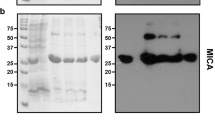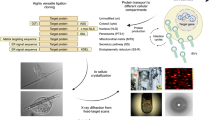Abstract
Eight combinations of molecular chaperones (e.g., DnaK/DnaJ/GrpE/ClpB) are co-expressed with the target recombinant protein to compare their effectiveness in improving its soluble yield. This system allows the most complete and rational approach proposed so far to use the chaperone activity for optimizing the host cell folding machinery. Furthermore, a two-step protocol is presented, in which protein synthesis and protein refolding are uncoupled. Molecular chaperones and target protein accumulate in the first growth phase and target protein aggregates are then disaggregated in vivo after the block of protein synthesis. The optimal chaperone combination to maximize the soluble yield of a specific protein remains unpredictable. Therefore, a small-scale purification selection step is useful for screening among expression combinations before scaling-up production. Applying such a strategy, we could increase the solubility of 70% of the tested constructs with yields of up to 42-fold more protein than in controls. The procedure takes 2 d.
This is a preview of subscription content, access via your institution
Access options
Subscribe to this journal
Receive 12 print issues and online access
$259.00 per year
only $21.58 per issue
Buy this article
- Purchase on Springer Link
- Instant access to full article PDF
Prices may be subject to local taxes which are calculated during checkout




Similar content being viewed by others
References
Bukau, B., Deuerling, E., Pfund, C. & Craig, E.A. Getting newly synthetized proteins into shape. Cell 101, 119–122 (2000).
Thomas, J.G. & Baneyx, F. Protein misfolding and inclusion body formation in recombinant Escherichia coli cells overexpressing heat-shock proteins. J. Biol. Chem. 271, 11141–11147 (1996).
Houry, W.A., Frishman, D., Eckerkorn, C., Lottspeich, F. & Hartl, F.U. Identification of in vivo substrates of the chaperonin GroEL. Nature 402, 147–154 (1999).
Veinger, L., Diamant, S., Buchner, J. & Goloubinoff, P. The small heat shock protein IbpB from Escherichia coli stabilizes stress-denatured proteins for subsequent refolding by a multichaperone network. J. Biol. Chem. 273, 11032–11037 (1998).
Goloubinoff, P., Mogk, A., Ben Zvi, A.P., Tomoyasu, T. & Bukau, B. Sequential mechanism of solubilization and refolding of stable protein aggregates by a bichaperone network. Procl. Natl. Acad. Sci. USA 96, 13732–13737 (1999).
Mogk, A., Deuerling, E., Vordelwulbecke, S., Vierling, E. & Bukau, B. Small heat shock proteins, ClpB, and the DnaK system form a functional triade in reversing protein aggregation. Mol. Microbiol. 50, 585–595 (2003).
Kiefhaber, T., Rudolph, R., Kohler, H.H. & Buchner, J. Protein aggregation in vitro and in vivo: a quantitative model of kinetic competition between folding and aggregation. Biotechnology 9, 825–829 (1991).
Schrödel, A. & de Marco, A. Characterization of the aggregates formed during recombinant protein expression in bacteria. BMC Biochem. 6, 10 (2005).
Goloubinoff, P., Gatenby, A.A. & Lorimer, G.H. GroE heat-shock proteins promote assembly of foreign prokaryotic ribulose bis-phosphate carboxylase oligomers in Escherichia coli. Nature 337, 44–47 (1989).
Georgiou, G. & Valax, P. Expression of correctly folded proteins in Escherichia coli. Curr. Opin. Biotechnol. 7, 190–197 (1996).
Tomoyasu, T., Mogk, A., Langen, H., Goloubinoff, P. & Bukau, B. Genetic dissection of the roles of chaperones and proteases in protein folding and degradation in the Escherichia coli cytosol. Mol. Microbiol. 40, 397–413 (2001).
de Marco, A. & De Marco, V. Bacteria co-transformed with recombinant proteins and chaperones cloned in independent plasmids are suitable for expression tuning. J. Biotechnol. 109, 45–52 (2004).
de Marco, A., Deuerling, E., Mogk, A., Tomoyasu, T. & Bukau, B. Chaperone-based procedure to increase yields of soluble recombinant proteins produced in E. coli. BMC Biotechnol. 7, 32 (2007).
de Marco, A., Vigh, L., Diamant, S. & Goloubinoff, P. Native folding of aggregation-prone recombinant proteins in Escherichia coli by osmolytes, plasmid- or benzyl alcohol-overexpressed molecular chaperones. Cell Stress Chaperones 10, 329–339 (2005).
Carrió, M.M. & Villaverde, A. Protein aggregation as bacterial inclusion bodies is reversible. FEBS Lett. 489, 29–33 (2001).
de Marco, A. Two-step metal affinity purification of double-tagged (NusA-His6) fusion proteins. Nat. Protoc. 1, 1538–1543 (2006).
De Marco, V., de Marco, A., Goldie, K.N., Correia, J.J. & Hoenger, A. Dimerization properties of a Xenopus laevis kinesin-II carboxy-terminal stalk fragment. EMBO Rep. 4, 717–722 (2003).
Steczko, J., Donoho, G.A., Dixon, J.E., Sugimoto, T. & Axelrod, B. Effect of ethanol and low temperature culture on expression of soybean lipoxygenase L-I in Escherichia coli. Protein Expr. Purif. 2, 221–227 (1991).
Makrides, S.C. Strategies for achieving high-level expression of genes in Escherichia coli. Microbiol. Rev. 60, 516–538 (1996).
Dinnbier, U., Limpinse, E., Schmid, R. & Bakker, E.P. Transient accumulation of potassium glutamate and its replacement by trehalose during adaptation of growing cells of Escherichia coli K-12 to elevated sodium chloride concentrations. Arch. Microbiol. 150, 348–357 (1988).
Diamant, S. et al. Dicarboxylic amino acids and glycine-betaine regulate chaperone-mediated protein disaggregation under stress. Mol. Microbiol. 49, 401–410 (2003).
Schultz, T., Liu, J., Capasso, P. & de Marco, A. The solubility of recombinant proteins expressed in Escherichia coli is increased by otsA and otsB co-transformation. Biochem. Biophys. Res. Commun. 355, 234–239 (2007).
Acknowledgements
I thank Dr. Bukau, Dr. Deuerling and Dr. Mogk for having provided the chaperone vectors and for their constant support and advice during the development of the methodologies.
Author information
Authors and Affiliations
Corresponding author
Rights and permissions
About this article
Cite this article
de Marco, A. Protocol for preparing proteins with improved solubility by co-expressing with molecular chaperones in Escherichia coli. Nat Protoc 2, 2632–2639 (2007). https://doi.org/10.1038/nprot.2007.400
Published:
Issue Date:
DOI: https://doi.org/10.1038/nprot.2007.400
This article is cited by
-
Strategies to enhance soluble production of heterologous proteins in Escherichia coli
Biologia (2022)
-
The co-expression of denileukin diftitox immunotoxin with Artemin: soluble and aggregation analysis in presence of an efficient protein chaperone
Biologia (2021)
-
Translational regulation of periplasmic folding assistants and proteases as a valuable strategy to improve production of translocated recombinant proteins in Escherichia coli
BMC Biotechnology (2020)
-
Improvement of stress tolerance and riboflavin production of Bacillus subtilis by introduction of heat shock proteins from thermophilic bacillus strains
Applied Microbiology and Biotechnology (2019)
-
Comparative study to develop a single method for retrieving wide class of recombinant proteins from classical inclusion bodies
Applied Microbiology and Biotechnology (2018)
Comments
By submitting a comment you agree to abide by our Terms and Community Guidelines. If you find something abusive or that does not comply with our terms or guidelines please flag it as inappropriate.



